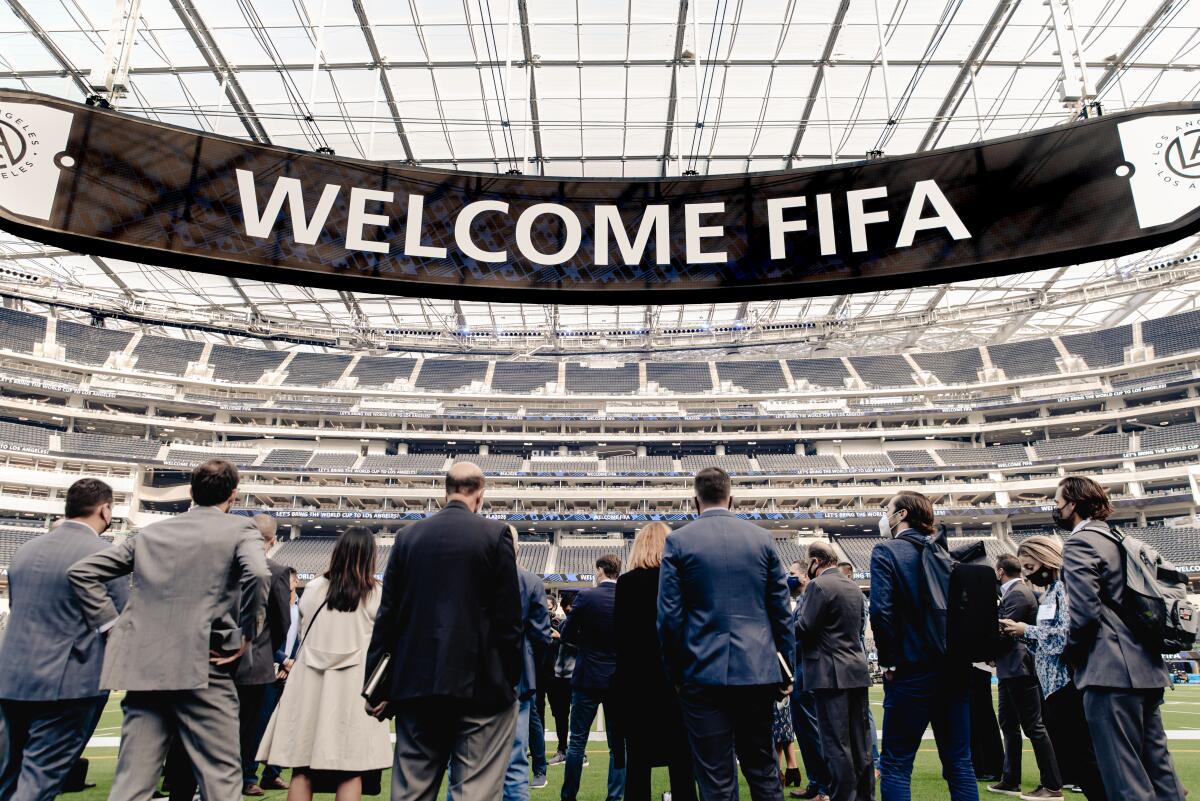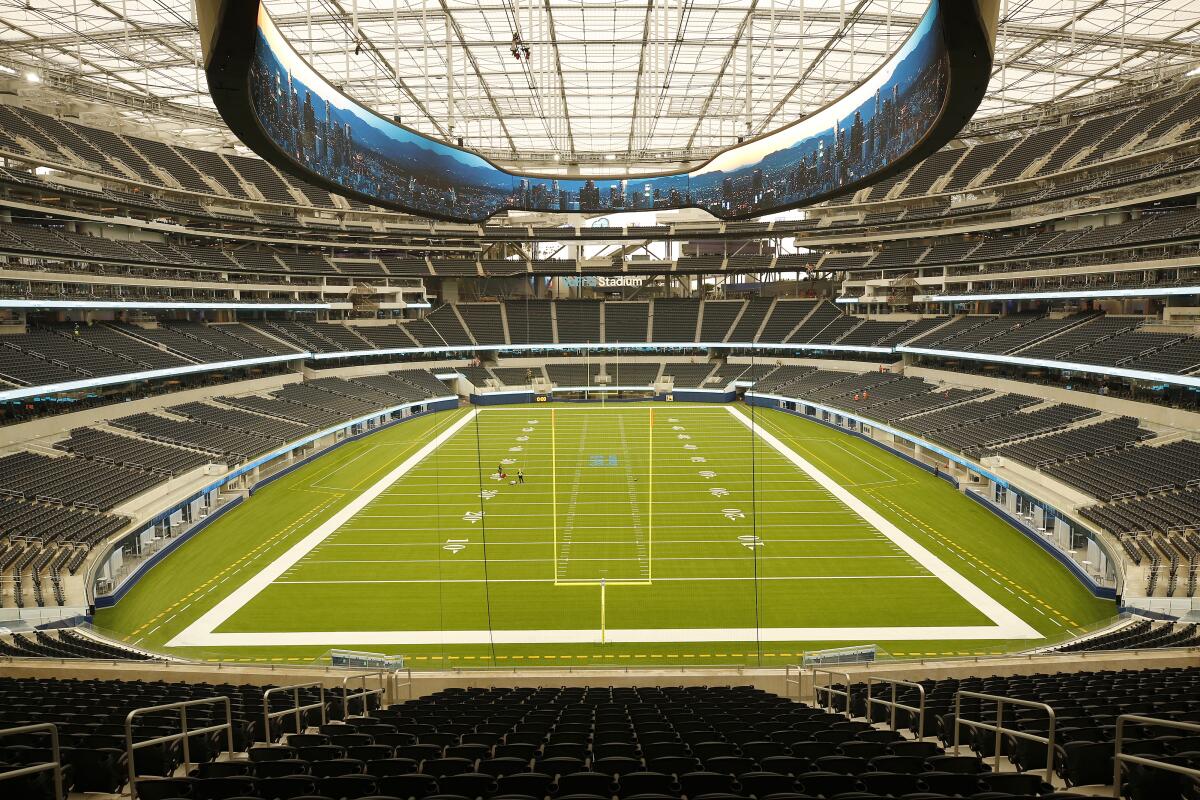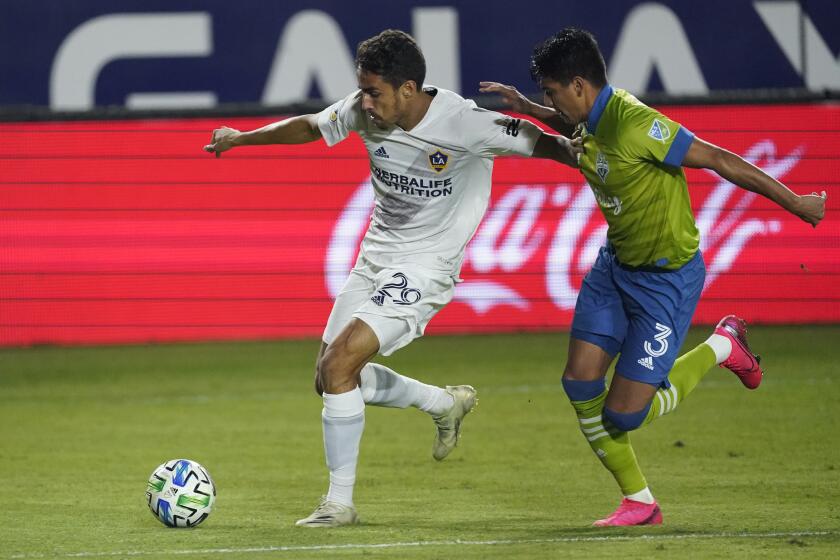Why SoFi might be odd stadium out for 2026 World Cup final

Southern California learned 20 months ago it would be hosting games for the 2026 World Cup. This weekend it will find out exactly which games it will get and when they’ll be played.
On Sunday the match schedule for the largest and most complicated World Cup in history will be announced by FIFA at noon Pacific time on Fox and Telemundo, the U.S. rights-holders for the tournament. And it might not go the way the Los Angeles World Cup host committee had hoped.
Multiple media reports in the U.S. and England have said the July final will be played in AT&T Stadium in Arlington, Texas, the 100,000-seat retractable-roof home of the NFL’s Dallas Cowboys. Those reports remain unconfirmed and Larry Freedman, a co-chair of the L.A. host committee, repeatedly has argued that Inglewood’s SoFi Stadium, the center of a palatial $5.5-billion complex built by Rams owner Stan Kroenke, should get that match.
MetLife Stadium in East Rutherford, N.J., is also in the running for the championship game.
The finals of the previous three World Cups held in the U.S. — the 1994 men’s tournament and the 1999 and 2003 women’s competitions — were played at the Rose Bowl and Dignity Health Sports Park. Yet for all its grandeur, SoFi Stadium, the only local venue chosen for the 2026 tournament, has some inherent problems.
World Cup games must be played on natural grass and SoFi, like seven of the other tournament venues, including AT&T and MetLife, has artificial turf. That can remedied with the installation of a temporary grass field sturdy enough to endure as many as eight games in six weeks.
More troublesome is the fact that SoFi’s field, built with the NFL in mind, is too narrow for soccer and FIFA is demanding expensive modifications to bring the pitch up to code. Kroenke reportedly agreed to spend millions on the upgrades, which are scheduled to begin Monday, but sought assurances the stadium would be awarded a marquee match in exchange.

However the stadium might be too small and too far from Europe to get the final.
SoFi squeezed in just 70,048 people for the 2022 Super Bowl and extending the playing surface will require removing seats in the lower bowl, dropping the capacity well below the 80,000 seats FIFA requires for a World Cup final. AT&T Stadium, on the other hand, easily can accommodate more than 90,000 people after making modifications to the field. That gives Arlington a huge advantage over SoFi and MetLife, said Alan Rothenberg, a former U.S. Soccer president who was the driving force behind the 1994 World Cup, still the most successful ever.
“It’s a financially driven decision. It’s clear that the stadium capacity that they have is so much greater,” said Rothenberg, whose sports marketing agency, Playfly Premier Partnerships, is advising half a dozen 2026 host cities. “The suites probably all balance out. But more than anything else, it’s the stadium capacity. It means a lot of revenue for them.”
FIFA can waive its rules regarding stadium capacity, but it can’t change the time, and central Europe is nine hours ahead of Inglewood, meaning a SoFi final would have to kick off by noon to end before midnight for television viewers on the continent.
Rothenberg doesn’t think that’s an issue.
“If you’re talking about heat in the summer, what’s the difference between noon and 3?” said Rothenberg, whose 1994 final at the Rose Bowl kicked off at 12:30 in 100-degree temperatures. “This is so big, if they did it at 9 in the morning, this would still be a sold-out, massive event.”
SoFi still is likely to be awarded some significant games. With the World Cup expanding to 48 teams, 104 games and 16 cities spread throughout the U.S., Mexico and Canada, some venues could get as many eight games, said a spokesperson for the Los Angeles host committee.
Orange County isn’t so much a soccer club as it is a European travel agency — which is exactly what players like Ethan Zubak were looking for.
FIFA officials are known to be infatuated with both the Southern California market and SoFi Stadium, which has a panoply of luxury boxes and tunnel entrances, exactly the kind of opulence and faux privacy the federation’s royalty loves. Stadiums need just 60,000 seats to stage a semifinal, according to FIFA’s often-elastic regulations, and in recent months, as the final increasingly appeared out of reach, members of the L.A. organizing committee quietly acknowledged a final-four game or even the U.S. team’s group-play opener would be acceptable.
There are potential hiccups with that plan too. The Athletic reported Thursday that U.S. Soccer and coach Gregg Berhalter will have a say in where the Americans train, play and travel during the World Cup, and with the federation moving its national training center to Atlanta, Berhalter might prefer keeping his team on the East Coast through the group stage.
“From L.A.’s standpoint, if we can’t get the final, the hope is eight games, hopefully an opening and certainly a semi and maybe a quarter if possible,” said Rothenberg, who lives on the Westside but is not a member of the local organizing committee. “I’d be disappointed if we don’t get that.”
The match schedule was expected to be released last fall but was delayed several months as FIFA officials paid additional visits to the host cities, 11 in the U.S., two in Canada and three in Mexico. In addition to the size of the playing surfaces and stadium capacities, World Cup organizers also appeared to worry about the weather. North America was rocked by severe weather last summer, raising concerns that similar conditions could impact the tournament. That probably worked to AT&T Stadium’s favor as well since its retractable roof makes it one of the largest air-conditioned rooms in the world.
Geography also favors AT&T Stadium. Arlington is a three-hour flight from Los Angeles and just an hour more from New York, which would allow FIFA to play semifinals on both coasts and have the winners meet in the middle for the final.
Yet regardless of who gets what game, Rothenberg said the real work for the 16 host cities will begin after Sunday’s announcement, which will leave them with just more than two years to get ready.
“They’ve been waiting a long time,” he said. “So they’re going to be delighted and relieved. And also realize now that they’ve got to entertain the burden of making this thing happen in a couple of years.”








